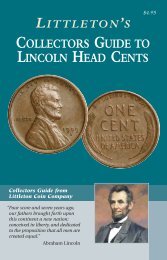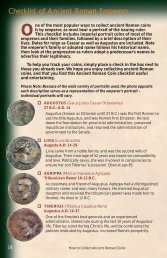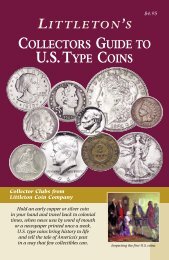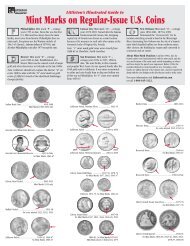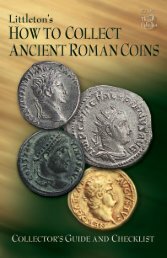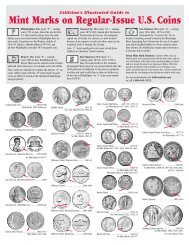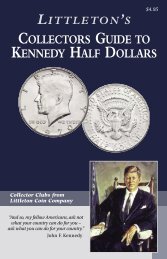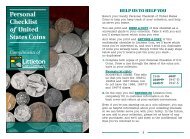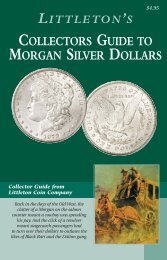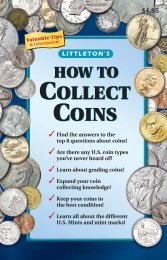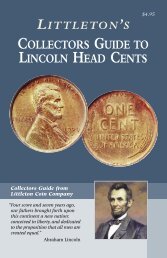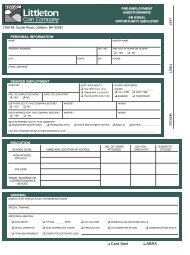Collecting Paper Money - Littleton Coin Company
Collecting Paper Money - Littleton Coin Company
Collecting Paper Money - Littleton Coin Company
You also want an ePaper? Increase the reach of your titles
YUMPU automatically turns print PDFs into web optimized ePapers that Google loves.
paper money glossary<br />
{<br />
32<br />
The cancellation<br />
punch above shows<br />
this note has been<br />
redeemed.<br />
Check number used<br />
to cross reference<br />
plate numbers on<br />
the note’s face.<br />
|<br />
www.littletoncoin.com<br />
Anti-Counterfeiting Measures Actions taken to prevent<br />
the unauthorized duplication of U.S. currency. See<br />
Greenback; Microprinting; Portrait; Security Thread;<br />
Watermark (see page 30).<br />
1 Back This is the preferred term for the reverse side of<br />
a paper note.<br />
Back Plate Number A small number found at the lower<br />
right of the Back of a note; officially known as a Check<br />
Number. This number provides a cross-reference to the<br />
Plate Serial Number on the front of the note.<br />
Bank Note A piece of paper currency issued by a bank,<br />
either private or government. Commonly used to refer to<br />
paper money whether bank issued or not.<br />
BEP The Bureau of Engraving and Printing (see below).<br />
2 Border The outer edge of the design on either the face<br />
or back of a note where the design ends and the plain<br />
currency paper outer margin begins.<br />
Brick A unit of measurement used by the BEP for paper<br />
money. A strap is 100 notes banded together. Forty straps<br />
are packaged together to make a brick consisting of 4,000<br />
notes and weighing about 8 1 ⁄2 pounds.<br />
Broken Bank Note <strong>Paper</strong> money issued by a now-defunct<br />
bank that has failed; may also be referred to as an Obsolete<br />
Bank Note.<br />
Bureau of Engraving and Printing Also referred to as<br />
BEP, established in the early days of the Civil War and<br />
formally recognized in 1869. Since 1887, it has printed all<br />
paper currency for the United States. Over its history, the<br />
BEP has also printed U.S. postage and revenue stamps,<br />
treasury bonds, and food coupons.<br />
Cancellation A hand stamp or punch that signifies the<br />
note has been redeemed or withdrawn.<br />
3 Check Number A small number found at the lower<br />
right of the back of a note, used to cross-reference with<br />
plate numbers on the face of the note. Check Number is the<br />
correct term for Back Plate Number.<br />
Colonial Currency Pre-Revolutionary War paper money<br />
issued by the individual colonies.<br />
Condition The grade or state of preservation of a piece of<br />
paper currency.<br />
Continental Currency <strong>Paper</strong> money first issued in 1775<br />
by the Continental Congress to finance the Revolutionary<br />
War, originally backed by Spanish milled dollars. Eventually,<br />
these notes depreciated to the point of near-worthlessness,<br />
but today are prized by collectors. (See Shinplaster, page 35.)<br />
{littleton coin company



